7 Best Hip Thrust Variations (with Pictures!)
Building large and powerful glutes is almost synonymous with performing hip thrusts.
But with so many different types of hip thrust available, picking the right one can come down to minute differences in movement pattern. In this article, we’ve elected to describe the differences of the most effective hip thrust variants out there.
Before attempting advanced variations of the hip thrust (like the frog pump or B stance), we suggest first mastering the standard movement pattern of the double leg hip thrust. This will build a foundation of muscle and technical expertise with which you can safely perform more complex exercises.
What is a Hip Thrust?
A hip thrust is a compound posterior chain exercise performed in a semi-lying stance. Most variations involve the lifter utilizing hip extension to move the pelvis into a higher elevation than the legs as they remain in a partially-flexed position.
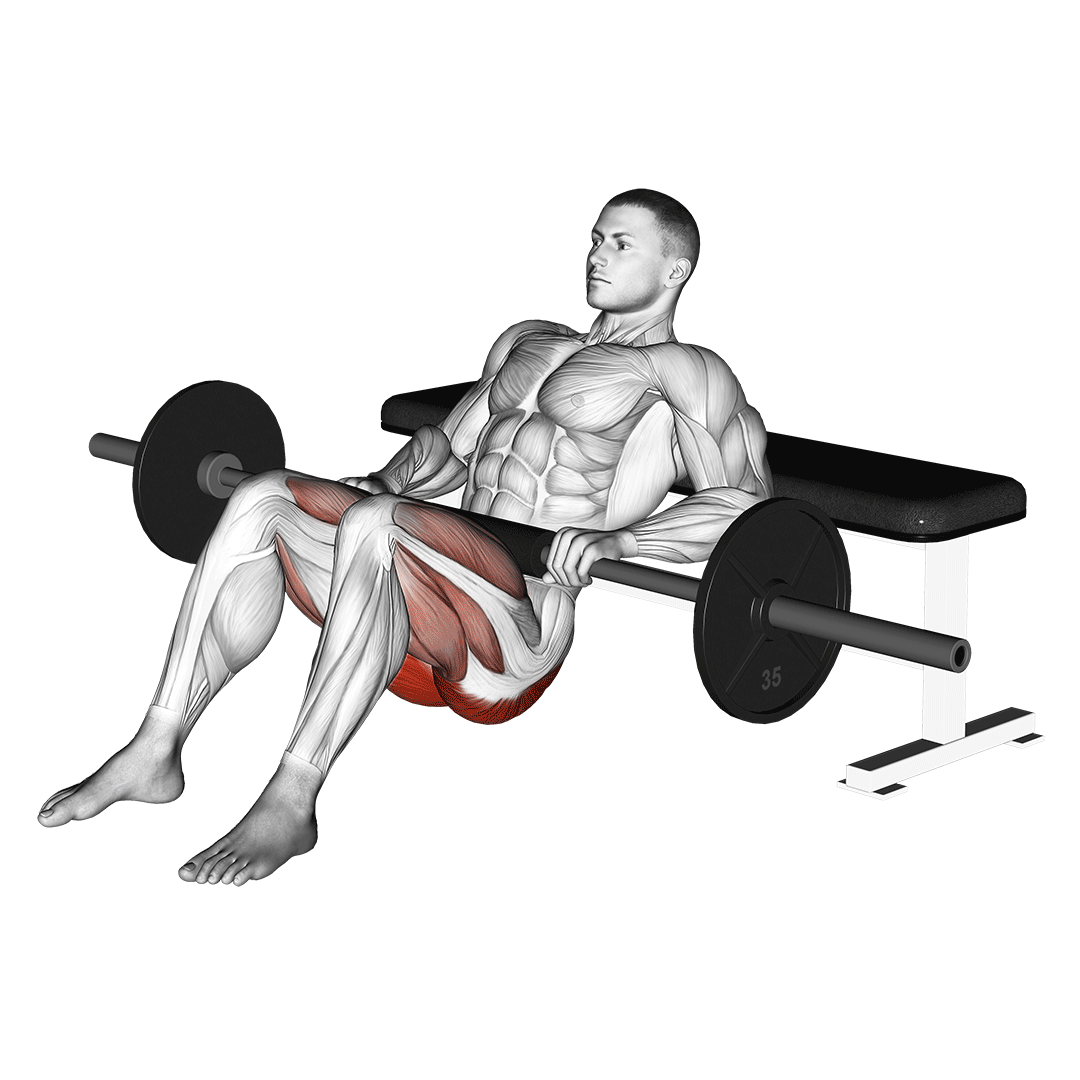
This characteristic mechanic means that hip thrusts will work the glutes to the greatest extent, all while simultaneously hitting the hamstrings and lower back as well.
Most hip thrust variations will differ based on the specific stance in which they are performed, with some featuring a unilateral or staggered stance, and others elevating different parts of the body so as to change the range of motion.
A Note on Hip Thrusts and Equipment
Because hip thrusts are performed with anything from bodyweight resistance to fully loaded and padded barbells, for the purposes of brevity, we’ve decided to only list variations of the exercise based on movement pattern.
The majority of the following hip thrust variations can just as readily be loaded with weights as they can be performed with no equipment at all. It is up to the lifter to decide how best to equip themselves when doing these variations.
Hip Thrust Variations
1. The Conventional Hip Thrust (Double Leg Hip Thrust)
The double leg hip thrust is the quintessential form of hip thrust, and is the variation that should be first mastered prior to attempting other kinds of hip thrust.
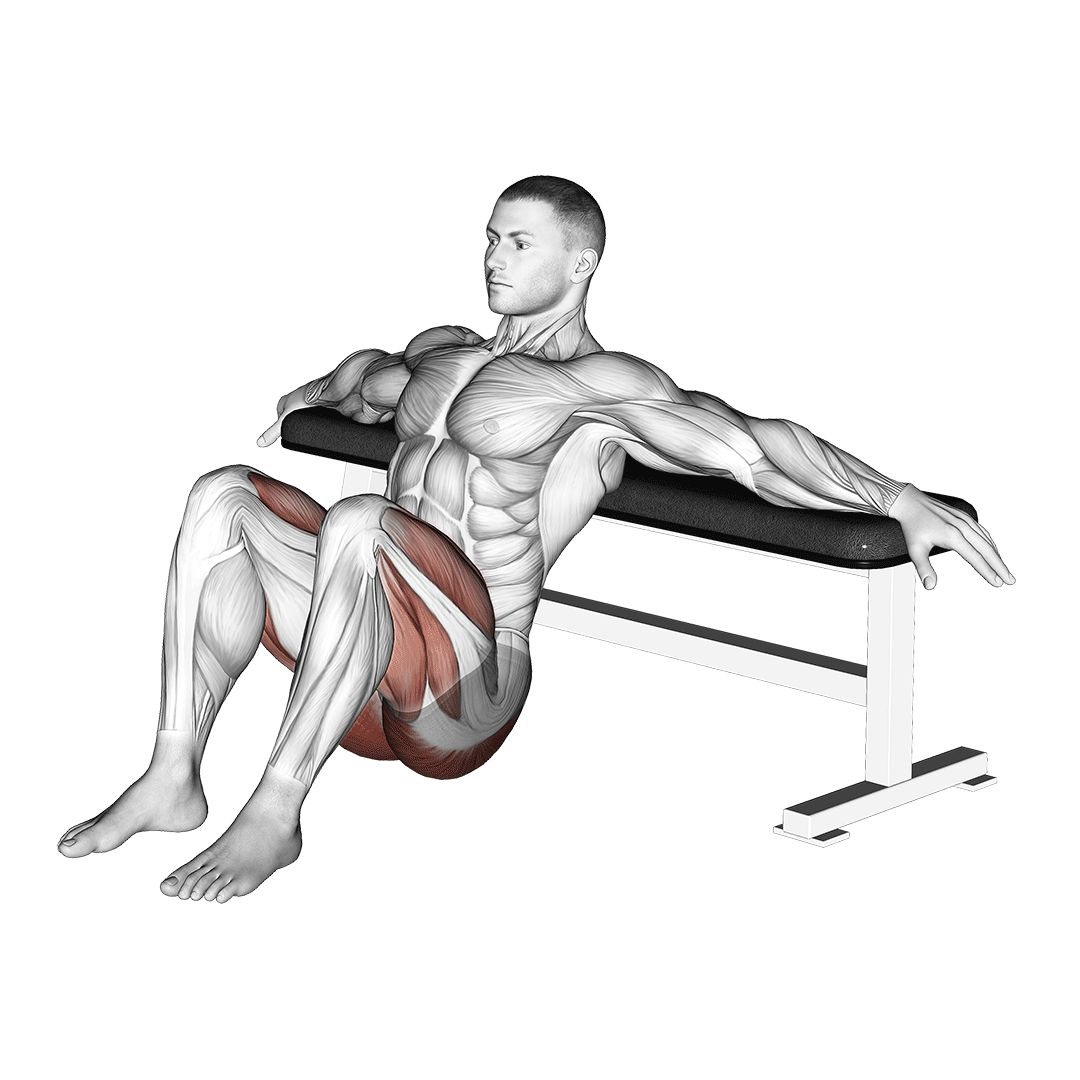
Like the majority of its variations, the conventional hip thrust is a compound exercise performed so as to strengthen, mobilize and hypertrophy the muscles of the lower posterior chain. It may be performed entirely unweighted, or with the use of various types of free weight equipment (or resistance bands).
Muscles Worked
Conventional hip thrusts primarily work the gluteal muscle group, but will also target the calves, hamstrings and - to a lesser extent - the lower back.
Benefits as a Hip Thrust Variation
The double leg hip thrust is the most basic form of hip thrust available. It teaches novice lifters proper hip extension mechanics, as well as the correct stance for performing other bilateral hip thrust variations.
In addition, few exercises are as effective at targeting the glutes with moderate volume and resistance as the basic hip thrust. More advanced lifters can take things a step further by adding resistance equipment into the mix.
How-to:
To perform a conventional hip thrust, the lifter will set their feet shoulder-width apart along the floor, upper back resting atop a bench and knees bent so as to allow for full hip extension. The arms may be spread along the bench for greater stability, or otherwise placed flat behind the back.
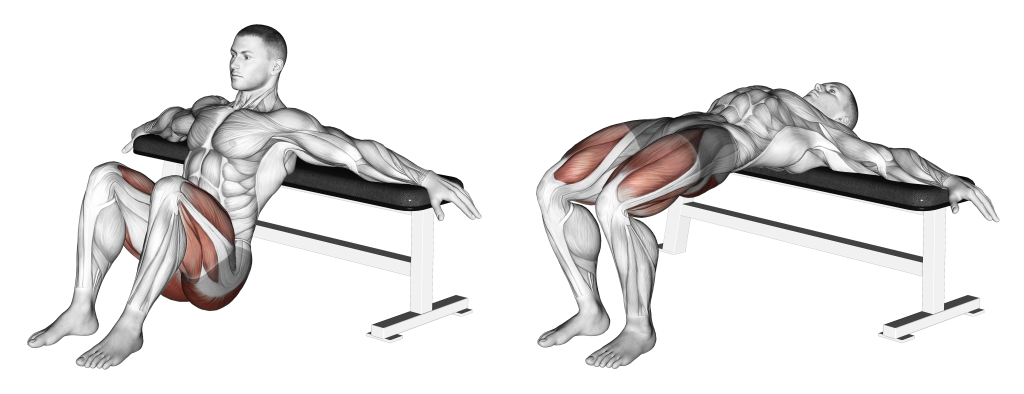
The hips should be at a lower elevation than the knees, forming a “V” shape with the body when viewed from the side. This is the standard hip thrust stance. In addition, weights may be placed atop the pelvis if performing the exercise with additional resistance.
Now in the correct stance, the lifter will squeeze their glutes and push their hips upwards - following the motion until the body forms a nearly flat plane from knees to shoulders.
At this point, the lifter will lower their hips back down to the starting position so as to complete the repetition,
2. The Single-Leg Hip Thrust
Whether for developing greater stability, correcting a muscular imbalance or upping the training intensity without further equipment, the single-leg hip thrust is the perfect variation.

As one can guess from its name, the single-leg hip thrust is simply a unilateral variation of the conventional hip thrust. One leg is elevated straight outwards, whereas the other remains in much the same position.
Apart from a unilateral stance, the single-leg hip thrust is otherwise identical to its bilateral counterpart.
Muscles Worked
The single-leg hip thrust will primarily work the glutes, but also target the hamstrings and calves to a lesser extent. Of course, this is only with the working side of the body.
Benefits as a Hip Thrust Variation
A major benefit of unilateral exercises is their capacity to correct muscular imbalances and otherwise improve muscular contraction by allowing more focus to be given towards one side of the body at a time.
Correcting imbalances and upping training intensity aside, the single-leg hip thrust is also quite effective for bodyweight athletes that find the conventional double-leg variation to be too easy.
How-to:
To perform a single-leg hip thrust, the lifter will first assume the standard double-leg hip thrust stance. Knees bent, feet shoulder-width apart and upper back resting atop a bench.

Once in the correct stance, the lifter will extend one leg straight forwards, spreading their arms along the bench if greater stability is needed.
Now balanced on only one leg, the lifter will squeeze their glutes and push their hips upwards - taking care not to tilt towards the sides as they do so.
When reaching a full range of motion, the lifter then lowers their hips back downwards.
This completes the repetition.
Don’t forget to repeat the same action with the opposite side.
3. The Heel Elevated Hip Thrust
The heel elevated hip thrust is a sort of inverted version of the conventional hip thrust, with the feet being elevated higher than the torso and the upper back being atop the floor.
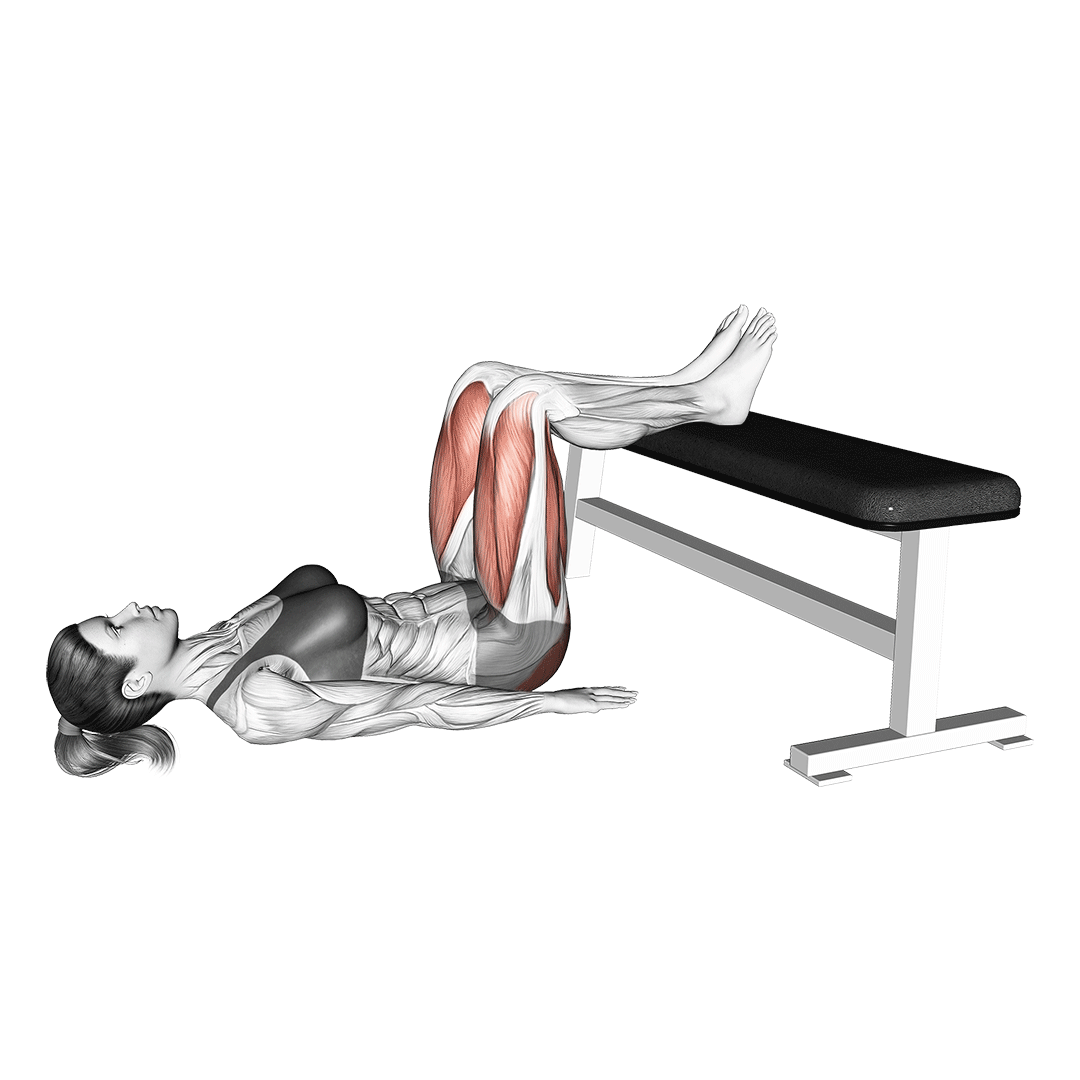
Apart from being great for the core, performing hip thrusts in this manner improves hamstring recruitment due to the unique angle of resistance and position of the legs in relation to the pelvis.
Of course, this particular variation is difficult to actually load with additional weight without reducing the elevation of the feet.
We advise caution if using barbells or other forms of free weight equipment.
Muscles Worked
The heel elevated hip thrust works the hamstrings to a greater extent than most other hip thrust variants, but will nonetheless also target the glutes quite effectively. In addition, the core (particularly the abs) are worked as well.
However, unlike other variations, the calves do not play a role in this type of hip thrust.
Benefits as a Hip Thrust Variation
The main benefit of the heel elevated hip thrust is its greater capacity for hamstring recruitment. This is further compounded by its slightly wider range of motion and unique angle of resistance, allowing for superior lower posterior chain development in comparison to rightside-up variations.
How-to:
To perform a heel elevated hip thrust, the lifter will lie flat on their back atop the floor, placing their heels atop a bench or box just within distance of their legs. The knees should be bent at this starting position, with the hips beneath them.

Now in the correct stance, the lifter will squeeze their glutes and push their hips out - continuing until their knees form a straight decline angle to their chest.
Once the hips are fully extended, the lifter then returns them back to the floor so as to complete the repetition.
4. The Kneeling Hip Thrust
Unlike other hip thrust variations, the kneeling thrust is performed with the torso oriented upright and the lifter resting on their knees and toes.
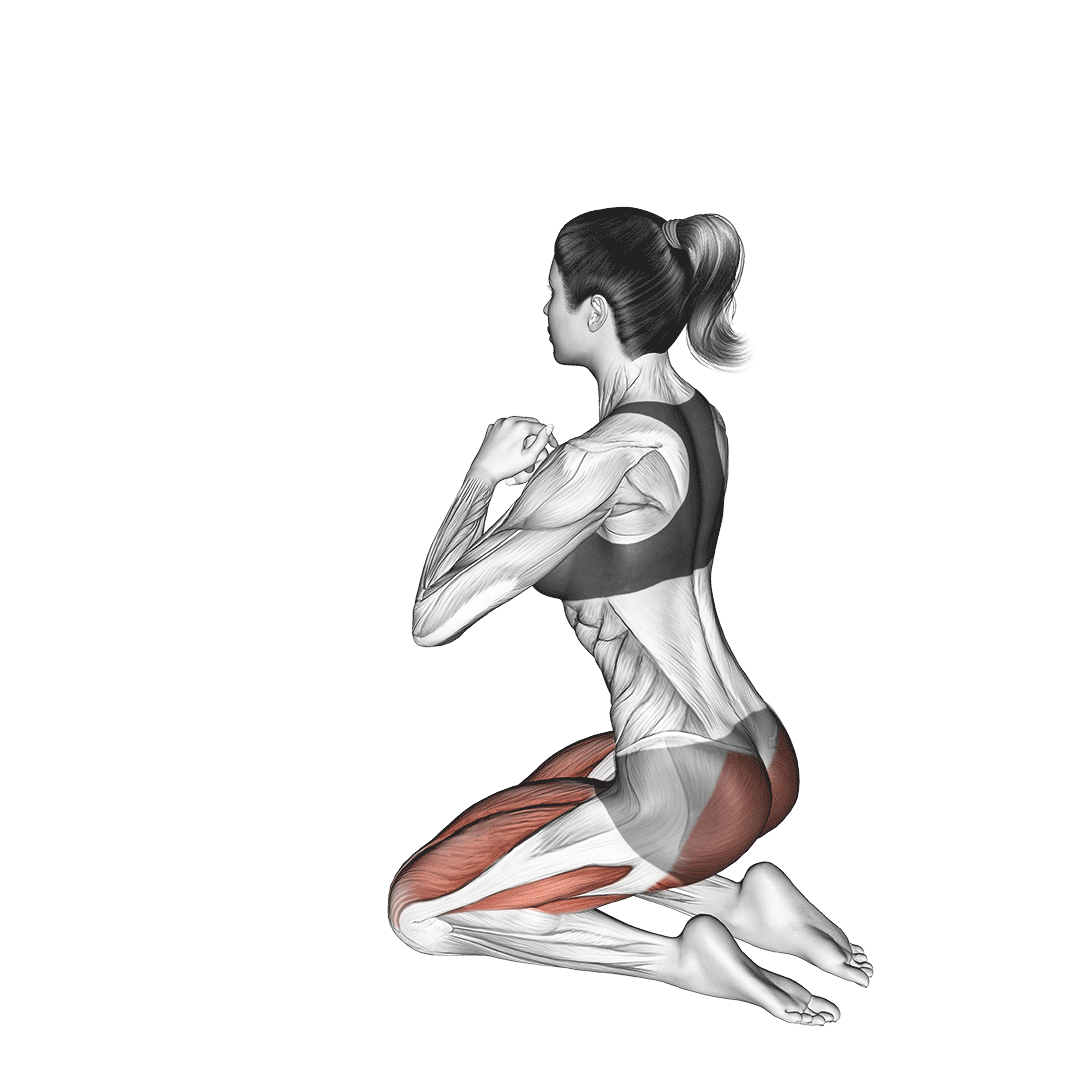
This maximizes the exercise’s utilization of hip hinge mechanics, and is the perfect solution for individuals who have trouble maintaining the horizontal position of a standard hip thrust.
At a larger scale, the kneeling hip thrust is much the same as any other hip thrust. The exercise begins with the hips in a state of flexion before the lifter contracts their posterior chain and extends their hips forwards.
Muscles Worked
Kneeling hip thrusts target the glutes and hamstrings to a moderately intense extent. Once again, the calves are not utilized during this particular variation.
Benefits as a Hip Thrust Variation
The kneeling hip thrust’s main benefit is its upright stance. This not only eliminates the need for a bench, but also reduces the risk of lower back injury. Furthermore, the exercise features a significantly more functional use of hip hinge mechanics, allowing for indirect improvement of exercises like the deadlift or squat.
In addition, kneeling hip thrusts can be made more difficult by wrapping a resistance band around the pelvis.
How-to:
To perform a kneeling hip thrust, the lifter will kneel on their knees, resting their buttocks back on their heels. If performing the exercise with a resistance band, it should be wrapped around the hip crease.

Once in a kneeling position, the lifter will contract their core, ensure their spine is in a neutral orientation and squeeze their glutes. This should push the hips forwards, extending it until the thighs are vertically parallel with the knees.
From this point, the lifter will sit back on their heels - thereby completing the repetition.
5. The B Stance Hip Thrust
The B stance hip thrust is considered to be a hybrid between the conventional hip thrust and the single-legged hip thrust.
One leg is extended further away from the body than the other, providing better stability and support but shifting far more resistance towards the closer leg.
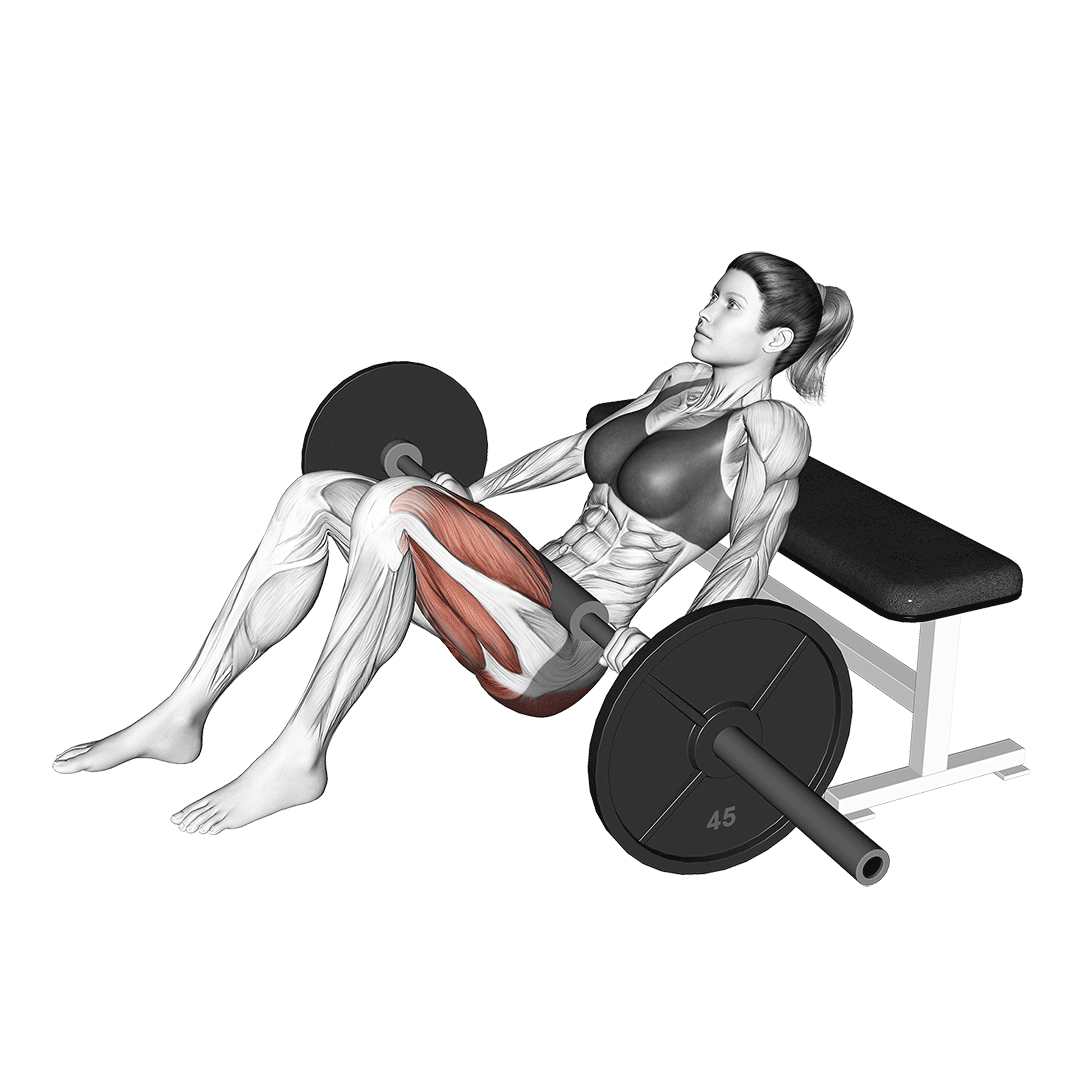
The B stance hip thrust is primarily used as a progression exercise to the single-leg hip thrust. That, or for individuals who wish to retain the benefits of the latter exercise but are using weights that are difficult to balance, such as a barbell.
Muscles Worked
The B stance hip thrust works the glutes, hamstrings, calves and lower back - more so in the closer leg than the one extended further away.
Benefits as a Hip Thrust Variation
B stance hip thrusts, as previously mentioned, are a less demanding and more convenient alternative to the single-leg hip thrust. Apart from this role, they are also excellent for maximizing training volume on one side of the body at a time.
How-to:
To perform the B stance hip thrust, the lifter will take the conventional hip thrust stance with their feet flat on the floor and their upper back atop a bench. From this position, they will slide one foot forwards, extending it until the heel is parallel to the toes of the opposite foot.

Now in a B stance, the lifter will proceed with the hip thrust as normal. To do so, they will squeeze their glutes and extend their hips upwards, stopping and reversing the movement once reaching their maximum range of motion.
Once the repetition is complete, the lifter should switch their legs so as to create an even distribution of volume.
6. The Frog Pump
Despite not being named as a hip thrust, the frog pump is the very essence of one - featuring much the same mechanics and purpose.
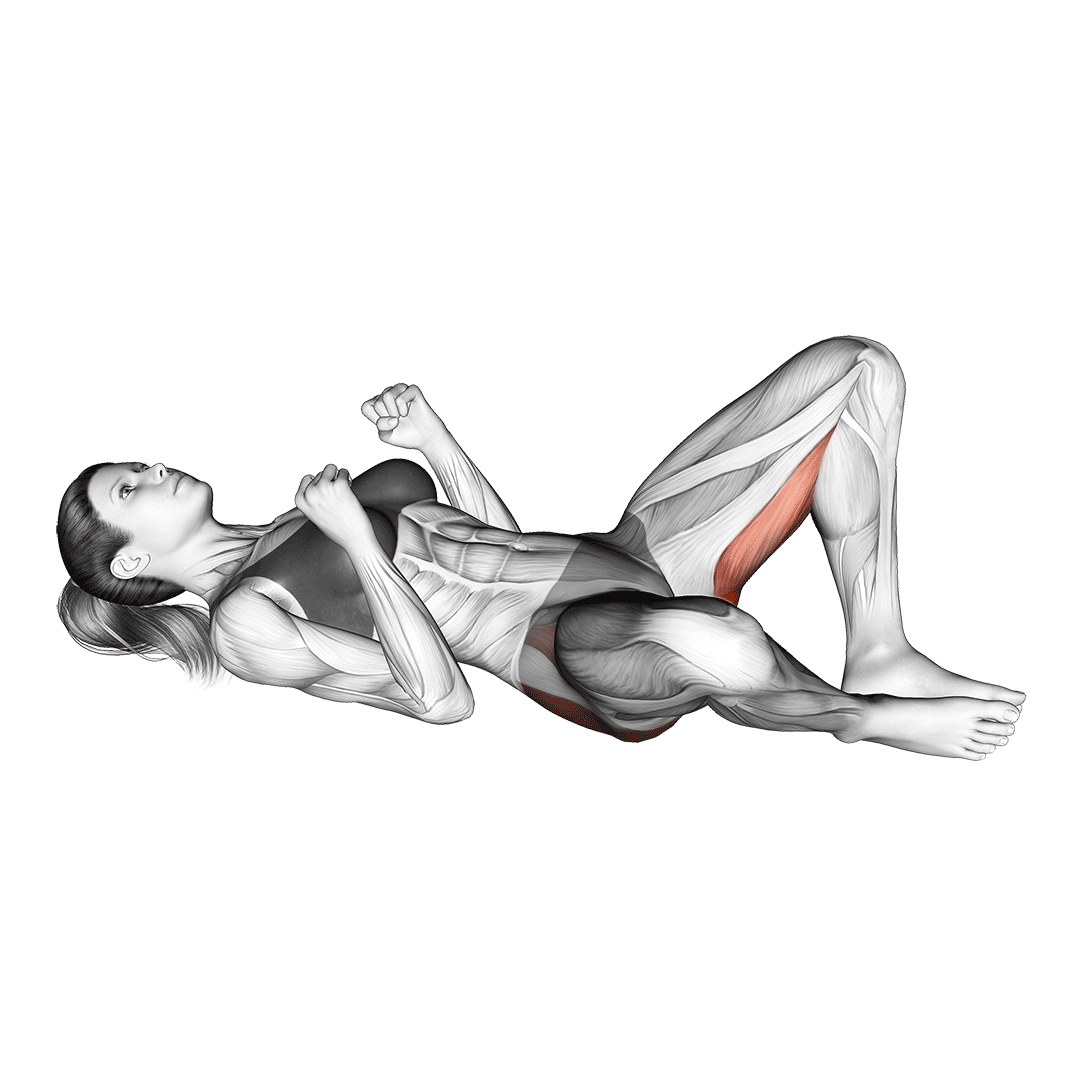
In addition to being an exercise meant to strengthen the posterior chain, the frog pump also targets the hip abductors and works the lower back to a greater extent. This is achieved by placing the lifter’s back flat on the ground and pressing the soles of their feet together, rather than on the ground - or with the back on a bench.
Muscles Worked
The frog pump targets not only the glutes and hamstrings, but also the smaller muscles of the lower back and the hip abductors.
Benefits as a Hip Thrust Variation
The frog pump can essentially be considered a cross between the glute bridge and the hip thrust, combining facets of both to produce a more comprehensive posterior chain workout.
In addition, frog pumps are excellent for recreating the same benefits of the hip thrust without the need for a bench or elevating the torso higher than the lower body.
How-to:
To perform a frog pump, the lifter will lie on the ground with their back, head and glutes supporting their body.

Setting their heels against each other and angling their knees out to the sides, the lifter will then brace their core and contract their glutes. Doing so should push the hips upwards, pressing the heels together as the hips are extended.
Once at a full range of motion, the lifter then releases their glutes and returns their hips to the floor - thereby completing the repetition.
7. The Double Bench Hip Thrust (Double Elevated Hip Thrust)
Although the double elevated hip thrust may appear odd at first, it does hold its own place as a highly effective and intense hip thrust variation.
This is on account of it featuring the largest range of motion among different hip thrust variants, allowing for the glutes and hamstrings to be worked to the fullest extent.
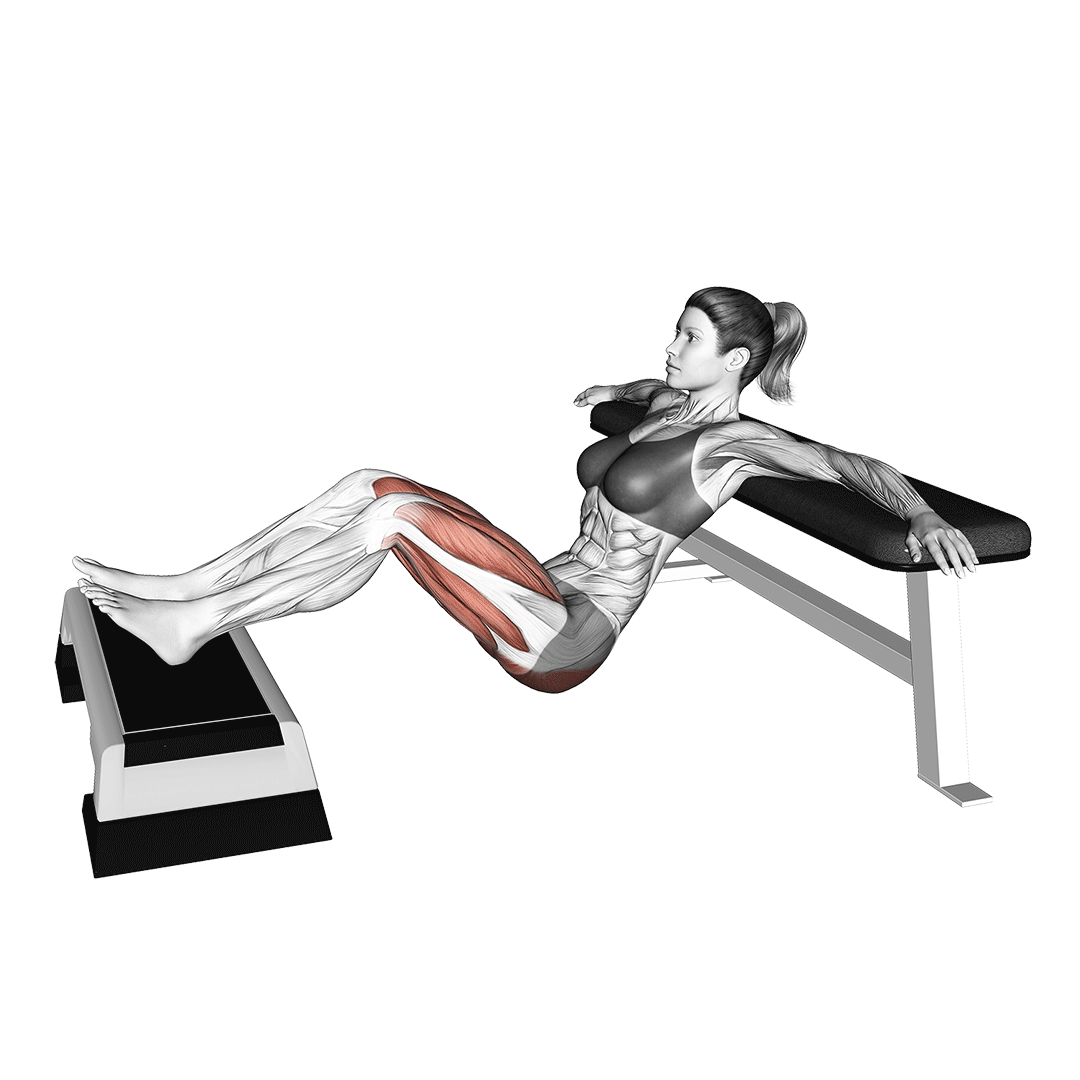
Apart from also being referred to as a double bench hip thrust, the exercise is also called the elevated heels and shoulders hip thrust.
Regardless of the name, the exercise requires two separate objects that the lifter may rest their upper back and heels on, preferably with enough space to lower the rest of their body between.
Muscles Worked
This particular hip thrust variant works the glutes and hamstrings to a comparatively greater extent than most. In addition, the core is also used to help suspend and stabilize the torso despite its odd stance.
Benefits as a Hip Thrust Variation
As touched upon previously, the double elevated hip thrust features a far larger range of motion in comparison to other variants. A greater range of motion equates to a longer time under tension, as well as the muscles being worked in a more comprehensive manner.
How-to:
To perform a double bench hip thrust, the lifter will first set a pair of benches (or similar objects) far enough apart for the lower body to be lowered between them.
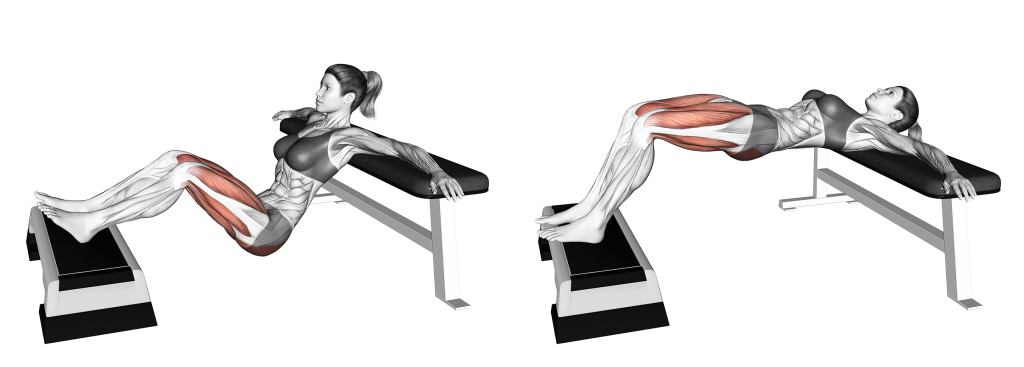
Then, placing the heels on one bench and their upper back on the other, the lifter begins the repetition by lowering their hips as low as possible between the benches.
Now at maximum depth, the lifter will squeeze their glutes as they extend their hips upwards, contracting the core so as to avoid rounding of the back.
Once a straight line is formed from the top of the knees to the sternum, the lifter then reverses the motion and returns their hips back down to the starting position. At this point, the repetition is complete.
Which Hip Thrust Variation Should You Do?
After the intermediate level of physical training, the conventional unweighted hip thrust can prove insufficient. More advanced lifters will either turn to using additional resistance or a more complex variation to keep progressing.
As such, it is best to first begin by mastering basic hip thrust mechanics prior to attempting it with a loaded barbell or a variation with more complex form.
For bodyweight exercise, try the single-leg hip thrust.
References
1. Contreras, Bret. Bodyweight Strength Training Anatomy. United States: Human Kinetics, 2013. ISBN: 9781492581772, 1492581771
2. Brown, Jason. Lower Body Training: The Definitive Guide to Increasing Size, Strength, and Athletic Performance. United States: Human Kinetics, 2022. ISBN: 9781718206885, 1718206887
